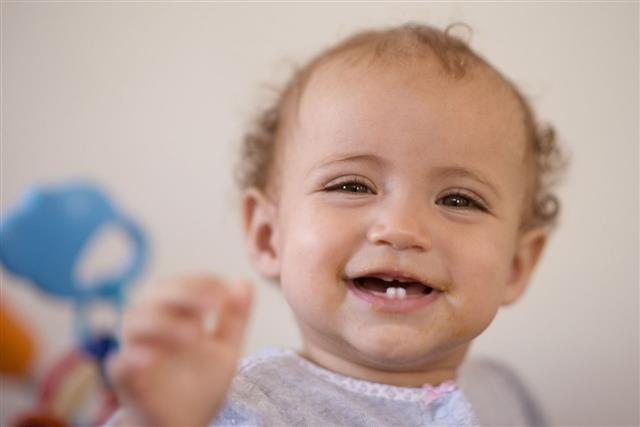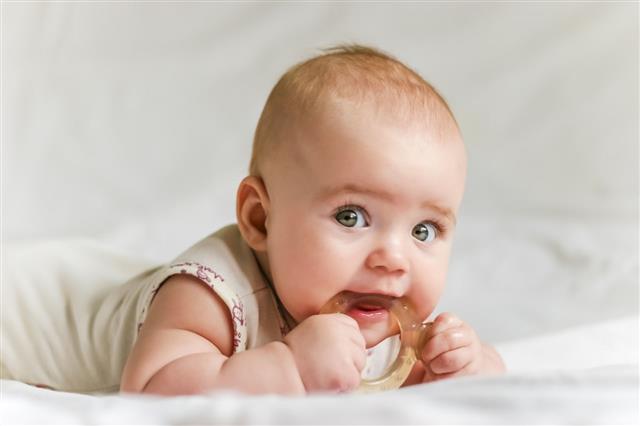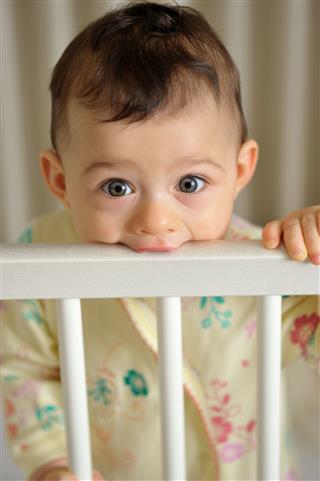
A couple of months after a baby’s birth, parents wonder when will their baby start teething. It is one of the important events in a baby’s life. Let us find an answer to this eternal question that parents face.
Did You Know?
One in every 2000 babies is born with teeth, which are called “natal teeth.”
These days, a number of parents maintain a log book of their child’s growing up milestones. Teething is one of those milestones, which parents want to chronicle. All babies start teething at a different age. In some kids, it is witnessed as early as 3 months while some, who are late bloomers, have to wait for a year or so. A “single tooth” smile from a little one is a wonderful sight that every parent looks forward to. Here we discuss in detail the teething pattern and the symptoms that your baby is likely to experience during teething.
When Do Babies Begin Teething?
It is very difficult to make a forecast about baby teething. There are no such parameters, which can be used to give an exact prediction about the teething time of a baby. It is said that babies are born with a full set of 20 primary teeth. These teeth are hidden under the gums, waiting to come out.
The Struggling Stage

This stage starts at 4 to 7 months. Babies teething at the age of 4 months is rare, although not impossible. A baby teething at around 9 months of age is also not uncommon. There are some babies who have even celebrated their first birthday giving a toothless smile! Most babies wear their “single tooth” smile when they are around 6 months old. If a baby does not start teething by the time it is 9 months old, it is always good to consult a pediatrician.
The Accomplishment Stage

This stage comes when the baby is around 15 to 16 months in which, the incisors and first molars have already erupted. After this, the canines come out followed by the second molars, and then the whole set finally erupts. When your baby turns around 3 years of age, you can click a perfect grinning picture with 20 shining baby teeth. As a matter of fact, teething has a hereditary pattern. Hence, both the parents should find out when did they get their first tooth.
Teething Pattern in Babies
The baby’s teeth — also called milk or primary teeth — appear in a certain order. Here are the various transitional stages (from gum development to pearly whites) that you are likely to come across in your baby.
1

The first to appear in the lower central incisors (bottom middle teeth) which erupt between 6-10 months.
2

Next comes the upper middle teeth, or upper central incisors between 8-10 months. It might extend up to 12 months as well in some.
3

At around 9-13 months, you will notice the upper lateral incisors appearing to the left and right of the central incisors, making it four on the upper side.
4

When your baby is around 10-16 months, the lower lateral incisors start showing up (on the left and right side of the central incisors), making it four in a row on the lower side.
5

At around 13-19 months is the stage when the first molar teeth are noticed on the upper side. They are much wider and appear on the backside of the baby’s mouth.
6

At around 14-18 months, you will notice the appearance of first lower molar teeth, giving company to the upper molars.
7

You will see the gap between the upper incisors and molars being filled by (upper) canine teeth, which show up at about 16-22 months of age.
8

Just like the upper canines, the lower canine teeth that show up at around 17-23 months cement the gap between lower molars and incisors.
9

All that remains on the lower side is the lower second molars that are seen to erupt at around 23-31 months.
10

Finally, to complete the circle, you will notice the upper second molars in your baby at around 25 to 33 months.
By the age of 3, your little one will possess a complete set of 20 baby teeth. Within a few years after getting a complete teeth set, they start to fall, which begins when your kid is close to age 6. They fall in the same pattern in which they arrived, starting from the middle bottom teeth.
It is important that you take care of the oral hygiene of your baby. Whatever the age of the baby, make sure you keep the teeth clean to avoid tooth decay. A soft cloth can be used to wipe the teeth of your baby.
Teething Signs
For some babies, teething is not a painful experience, but there are some unfortunate ones, who do suffer when they are teething. The symptoms of teething can be seen for days, or weeks in advance.
- When babies start teething, the gum where the tooth is going to appear may look red, swollen, and sore.
- A number of babies drool when they are about to teeth. However, there are some babies who drool naturally as well.
- When the baby is teething, it will bite anything it lays its hands on. This helps in relieving pressure under the gums.
- During the teething stage, some babies also suffer from fever.
- While teething, you may notice loss of appetite of your baby, or even their refusal to feed.
- When babies are teething, they get quite irritable and restless and may trouble you by not sleeping at night.
One of the simple methods of finding if your little one is teething is to run your fingers on the gums. On the place where the new tooth is emerging, you will feel a ridge. Many a time, teething causes immense discomfort for the babies. You can relieve your child of the discomfort by giving it a breadstick or carrot slice to chew on. You may also give a teething ring to your baby. If your baby is not very irritated, you can rub the gums of your child with clean fingers.
Teething Trivia
According to some pediatricians, girls teeth before boys.
Some physicians suggest giving the baby a chilled teething ring, while some are of the opinion that a cold teething ring can aggravate the pain associated with teething.
While teething, some babies do not want to eat, or nurse, whereas there are others who will nurse or eat more when they are teething.
Teething is indeed a wonderful stage in a baby’s life. So, all the best for the new phase in your little one’s life. Be sure you are ready with a camera to capture a beautiful “single tooth” smile.
































